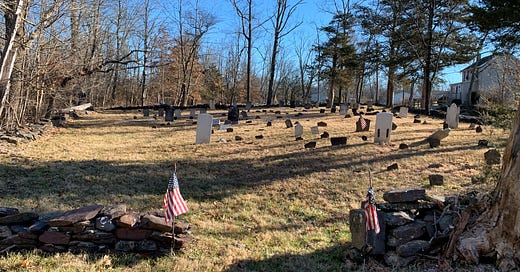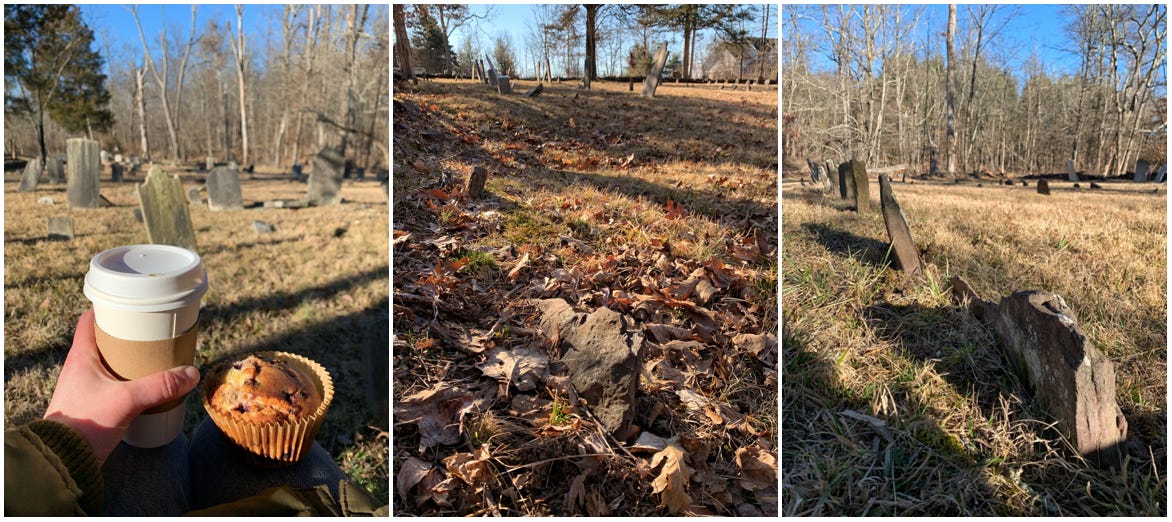Sunday Pastries With the Dead 14
The 1742-era Locktown Stone Church Cemetery in Locktown, NJ.
Today’s burial locale was a bit tricky to find at first—the affiliated cemetery for the current Baptist church building is around the corner on another street; a lasting testament to the original location of the worshippers’ gathering place.
This church’s congregation was established in 1742, when its members initially convened in a log cabin. The first burial in the cemetery beside that building was for their founding minister, in 1749 (his gravestone has long since succumbed to the elements). Later, a frame structure was erected nearby; in 1819 it was replaced by the currently-standing stone church pictured above. I couldn’t find any official information about this, but I’m inclined to believe—based on what I’ve seen of old Quaker meeting houses—that those two front doors were originally meant as separate entrances for men and women.
The adjoining cemetery isn’t marked on Google, so I poked around the church grounds and peered into the surrounding woods for a bit, wondering where it could be. I walked down a side road dotted with old barns and historic homes (one of which displayed an est. 1866 marker and was clearly a former one-room schoolhouse), becoming more frustrated with every step; it was a punishingly cold, blustery morning. I was relieved to see a woman exiting her house with a small scruffy leashed terrier.
I called out to ask if there was a cemetery nearby, and she gave me its whereabouts (I was to go back the way I came, take a left, take a right, and keep going until I saw headstones). We chatted about the history of the area; she told me the whole town was once farmland owned by one family, that her home was built in the early 1820s, and that, “An old Italian man used to live across the street and sell homemade dandelion moonshine. People came from miles away to buy it.” She sent me off with a warning to be careful where I stepped in the burial ground because, “A bunch of the graves are caving in.” That certainly put a pep in my step!
A short stroll later, I spotted the old stone wall of the cemetery—the picturesque plot is located beside a rushing creek; it was a calming soundtrack for my wanderings. Because there are no graves in the front left section of the cemetery, historians believe this is where the original log cabin stood. There are about 90 headstones here, most of them unidentifiable, but there are likely far more plots—many of the markers have been lost to time.
My neighborly connection was not kidding about the recessed ground—shards of what were once sandstone monuments jutted jaggedly astride rectangular body-length sections of depressed grass and soil. It’s not often that I’m given a visual of the location and position of the bodies beneath my feet, so I found this equally sobering and fascinating. And I kept a wide berth, of course.
This is a pretty humble place—its three most decorated residents are Richard Heath (above left) and his brother John (above middle), both Revolutionary War soldiers, as well as John Shepherd Sr. (above right), one of the church’s deacons and a member of the nearby school board.
A “fun” fact about the Heaths—their father, Andrew, took Richard’s place in the Revolutionary War in 1777 because he believed his son (then 17 years old) was too young to fight. Andrew died when he drank too much cold water and buttermilk after engaging in a skirmish with the British on a sweltering June day. There’s no official cause of death on record—does anyone want to hazard a guess? One can imagine that both his sons signed on in his memory, and perhaps their father’s protection from beyond helped them survive.
Within the graveyard are descendants of many of the most notable early families of the area. The Rittenhouses are the farmers my neighbor friend alluded to, who initially owned the land that was eventually conveyed to the church (the family settled here in the early 1700s). The Werts were German immigrants who had property nearby starting in the mid-1700s. The Mires family lived on the same street as the church as early as 1745 (Anna, pictured above third from the left, is a descendant who never married, thereby escaping the horrifying qualifier of “wife of” on her headstone. All hail Anna!) The Heaths owned property here as early as 1727.
The oldest remaining headstone is from 1793, marked “R.B.”—I couldn’t find it. Some of the earlier examples I happened upon were Mary Dils (above left), who died in 1810, five-year-old Amos Sutton (above center), who died in 1820, and Catherine Rittenhouse Heath (above right), who died in 1831.
Underscoring the salt-of-the-earth roots of its interred, there aren’t any ornate monument designs or symbols to speak of, save this glimpse I caught of a Civil War shield motif (above left). Many of the remaining stones, albeit largely illegible, had gorgeous weather-worn patterns, while others bore only initials. The fact that this sweet little spot shows its age makes it all the more endearing. Until next Sunday, fellow taphophiles!












Your poor hand was red from the cold 🥶 in your quest to NOT disappoint your faithful, greedy readers of our Sundays with the dead! Go YOU, KC! Thank you!